Your Cart is Empty
Earth Day: An Extra $25 goes to Coral.ORG on all SUPs | Free Shipping over $50
Earth Day: An Extra $25 goes to Coral.ORG on all SUPs | Free Shipping over $50

Ever wanted to learn how to stand up paddle board? Look no further - today’s your lucky day. What is stand up paddle boarding, you ask? Stand up paddle boarding, also known as SUP, consists of standing on a board and using a paddle to maneuver your way through the water. (And trust us, it’s totally lit.)
Paddle boarding was inspired by surfing, but instead of sitting on the board waiting for a wave to arrive as surfers do, paddle boarders move themselves forward anytime they please with the help of their trusty paddles.
Topics Covered in this Article
Once you try SUP for yourself, you’ll never want to leave your board. Here’s why you’ll love it.
Bring your BFF, partner, or even your dog on your board for an afternoon out on the water.
Stand up paddle boarding is an excellent way to work your core muscles - no sweating on the elliptical machine in crowded gym!
SUP is a great way to get fresh air. You’ll get in a fantastic working while soaking in the nature surrounding you.
Spoiler alert: stand up paddle boarding isn’t hard! If you’re a quick study, you can learn the basics in just a day or two. There are more challenging forms of SUP, like SUP surfing and long-distance SUP touring, but you can pick up everyday recreational paddling in a snap.
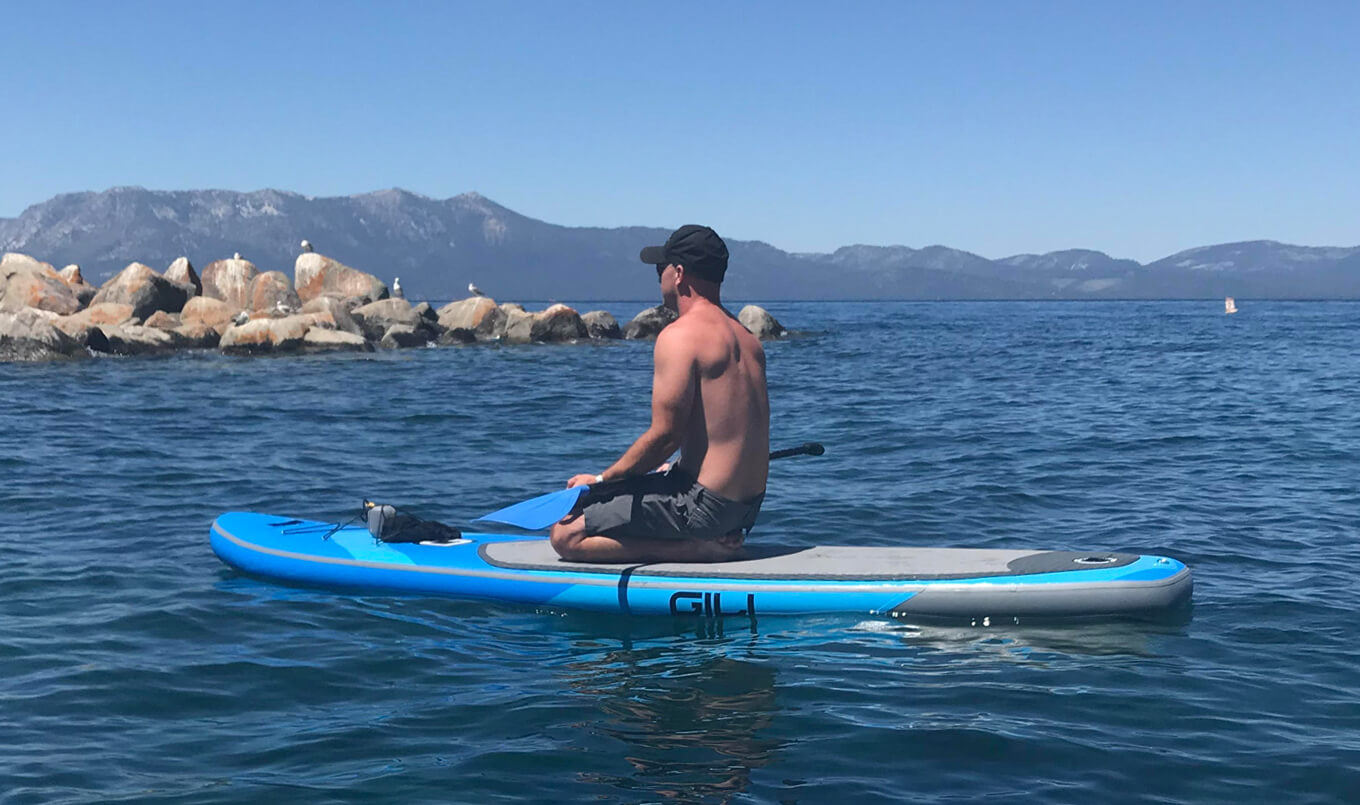
You'll find paddle boards in a range of different shapes, lengths, widths, and sizes. The most common paddle board size is 10'6 to 11' and 31" to 35" in width. SUPs are much bigger than your typical surfboard.
If you're a beginner, look for an All Around or Hybrid Paddle Board at least 10'6 in length and 31" in width. Make sure the board has enough volume to support your weight.
Check out How to Choose a Paddle Board to find that perfect board for you - from beginners to advanced paddlers.
Inflatable paddle boards (or iSUPs) inflate when you’re ready to use them, and can deflate when you want to store or transport them. iSUPs are easier to store and transport than hard paddle boards, which is a definite perk. Inflatable SUPs also float higher in the water, which is ideal for activities like SUP yoga. iSUPs are durable and can handle drops and dings, which makes them excellent for beginners.
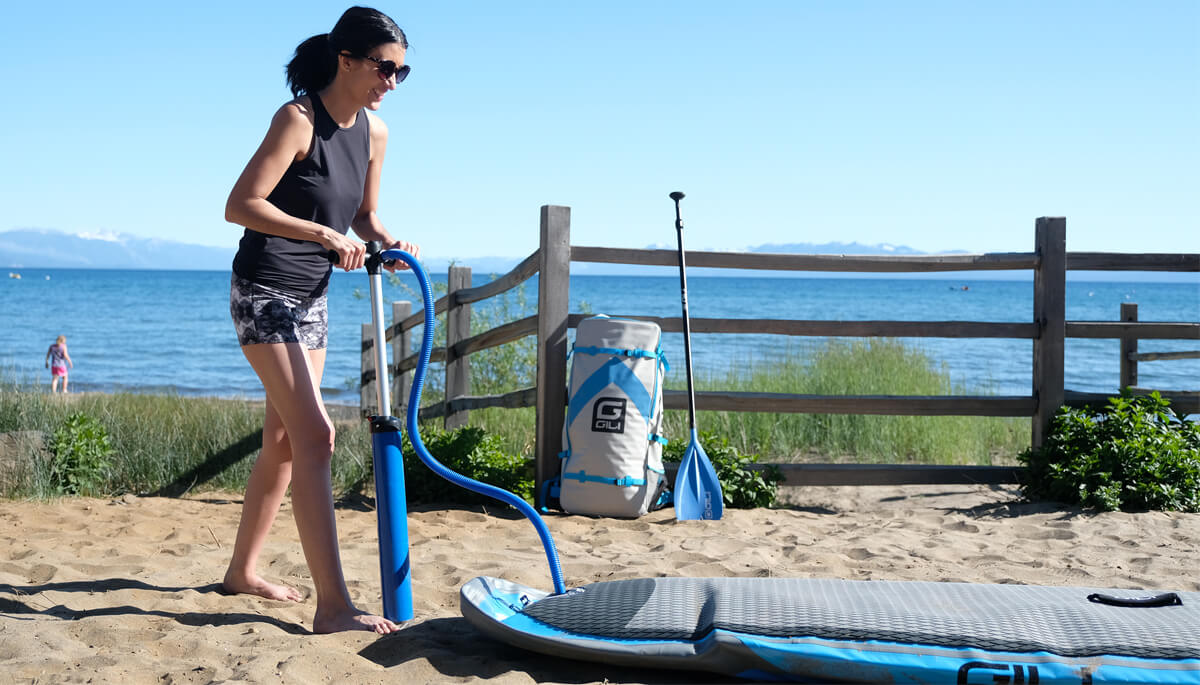
Hard SUPs are the more “traditional” types of paddle board. They’re made of an EPS foam core wrapped in materials like epoxy, fiberglass, wood, carbon fiber, or plastic. They tend to be slightly faster than inflatable SUPs, so perform better for SUP surfing, where you’ll need to be nimble on a solid board. On the other hand, hard SUPs have their downsides as well. They can be harder to store because they’re so big. They’re also tough to lug around, especially on windy days. (Prepare yourself: wind can push you and your board forward when you least expect it.)
If you’re just getting started with SUP, you’ll probably want to start with an all around paddle board. These are the most common type, and they make great SUPs for beginners. As their name implies, all around paddle boards are great for choice for many different types of stand up paddling.
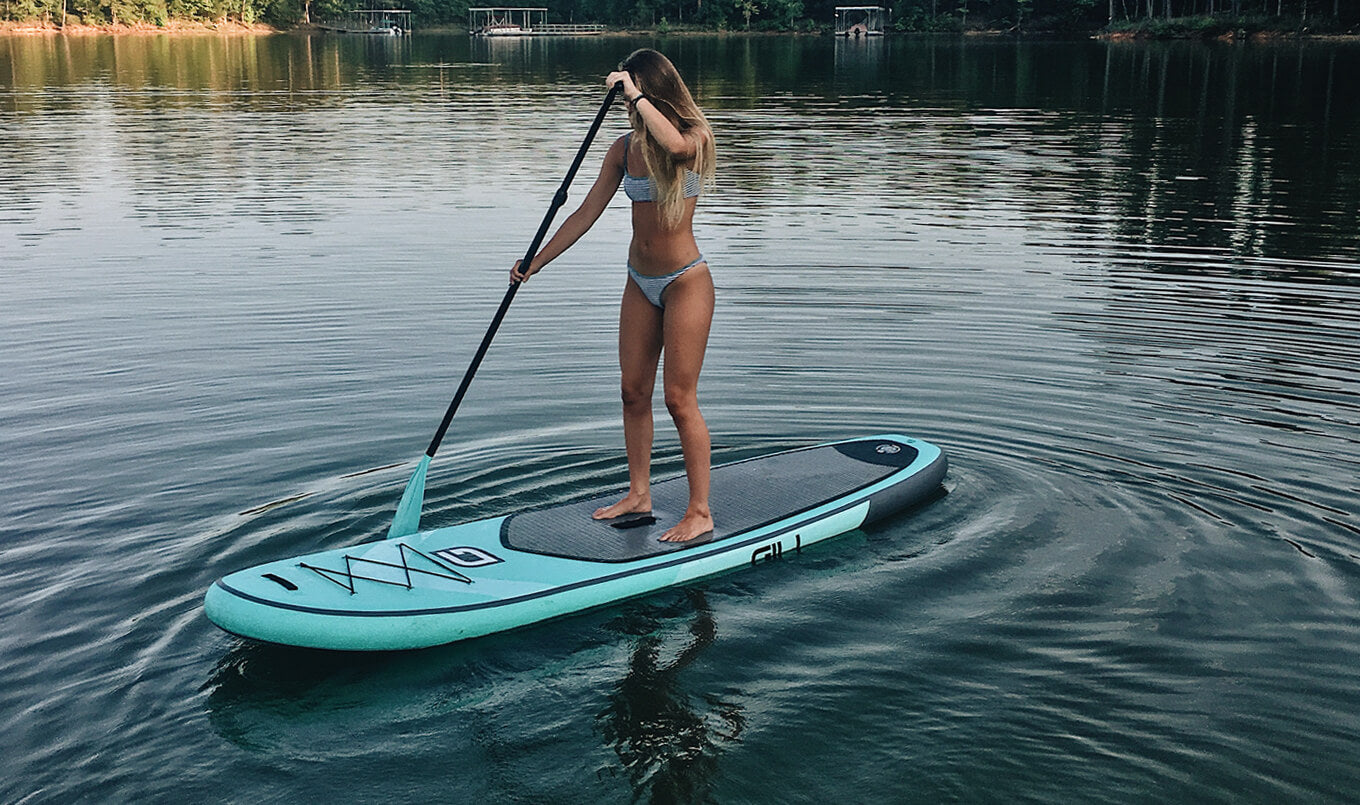
If you plan to fish on your SUP, you’ll want to look for a board with a wider deck (at least 31” but up to 36”). SUPs for fishing also tend to have attachments on them so you can mount or store your fishing gear on your SUP.
If you’re planning to do SUP yoga, get excited, because you’re about to get very zen and very Instagrammable. There’s a reason why so many people are flocking to SUP yoga right now: it’s a truly invigorating experience. If SUP yoga is your jam, you’ll want to look for a board with a wide deck (at least 31”) and a length of at least 10’ so you’ll have enough room to practice tree pose to your heart’s content.
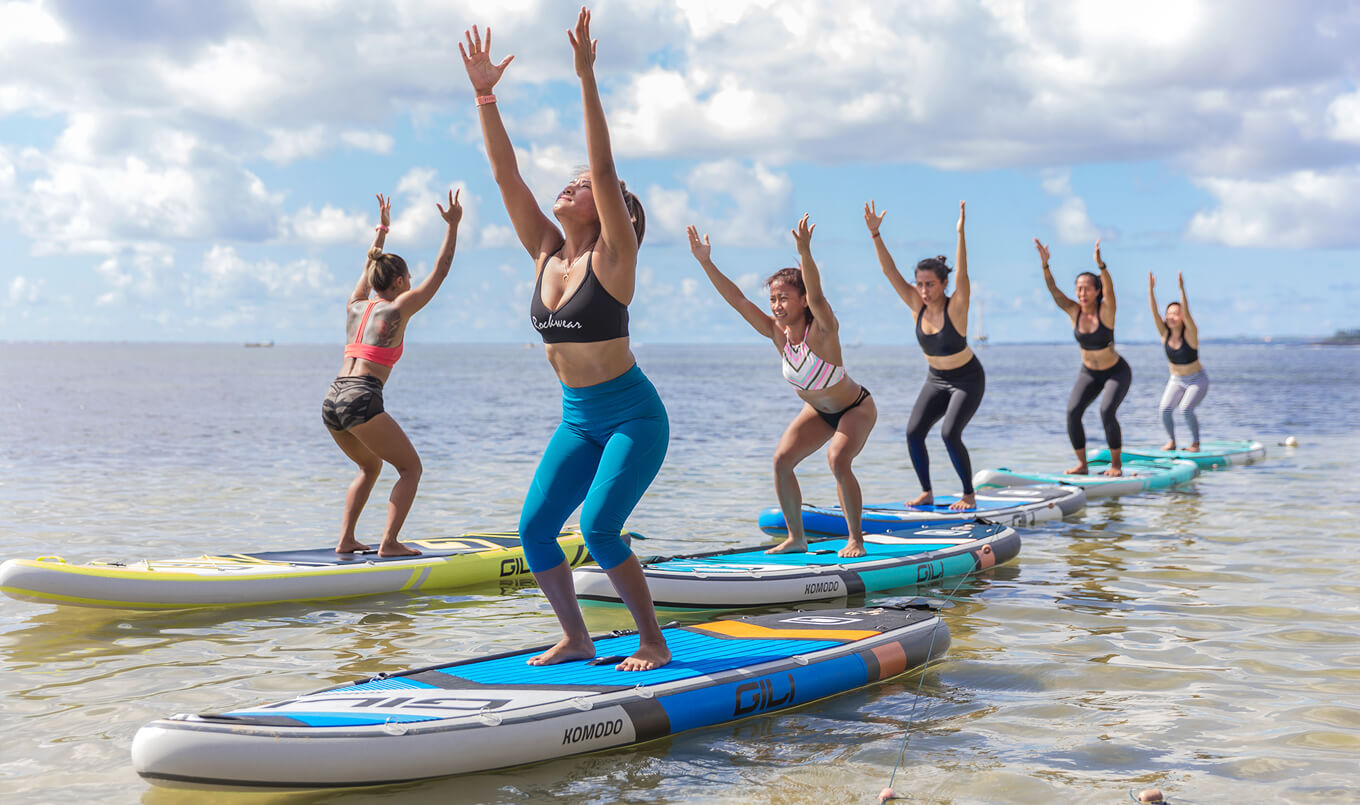
For SUP touring, you’ll want a longer and narrower board with a pointed nose and displacement hull. This can help you move more efficiently on long-distance SUP adventures.
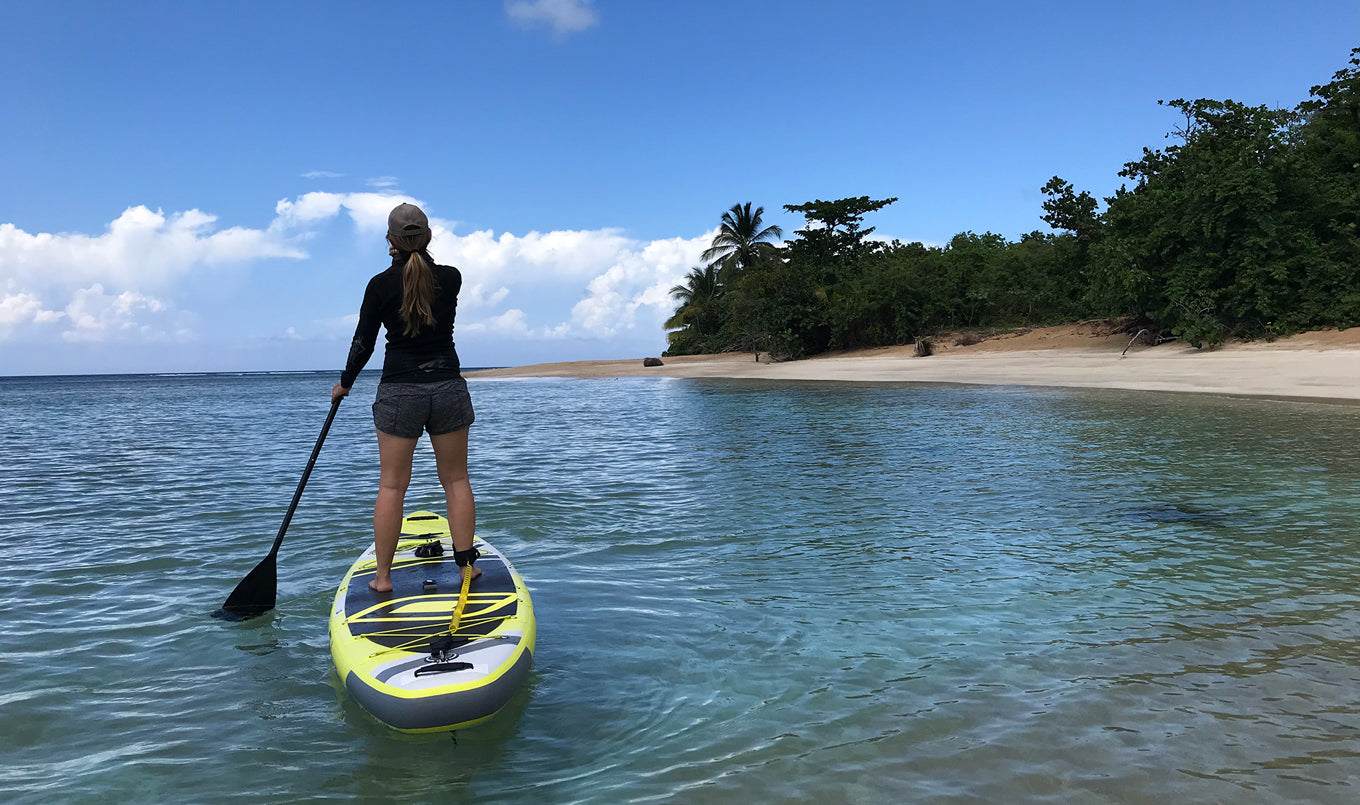
If you’re going to partake in SUP surfing, a smaller board is best so you can deftly maneuver through the waves. SUP surfing is best for more experienced boarders who are ready for a challenge.
Hybrid paddle boards are perfect for families or anyone who wants to do it all. Hybrid boards aim to provide versatility, and range from 10’6” to 12’ long, with widths of 33” to 35.” These boards typically provide a bit more stability, and are very versatile.
Here’s what to stock up on for a seamless SUP experience.
You knew this one already, right? You can’t SUP without, well, a SUP!
Equally important is your trusty paddle, which will be your second-in-command on every SUP adventure. Most sup paddles are adjustable, so the important thing is to be sure that you adjust it to your size - more on that in a moment.
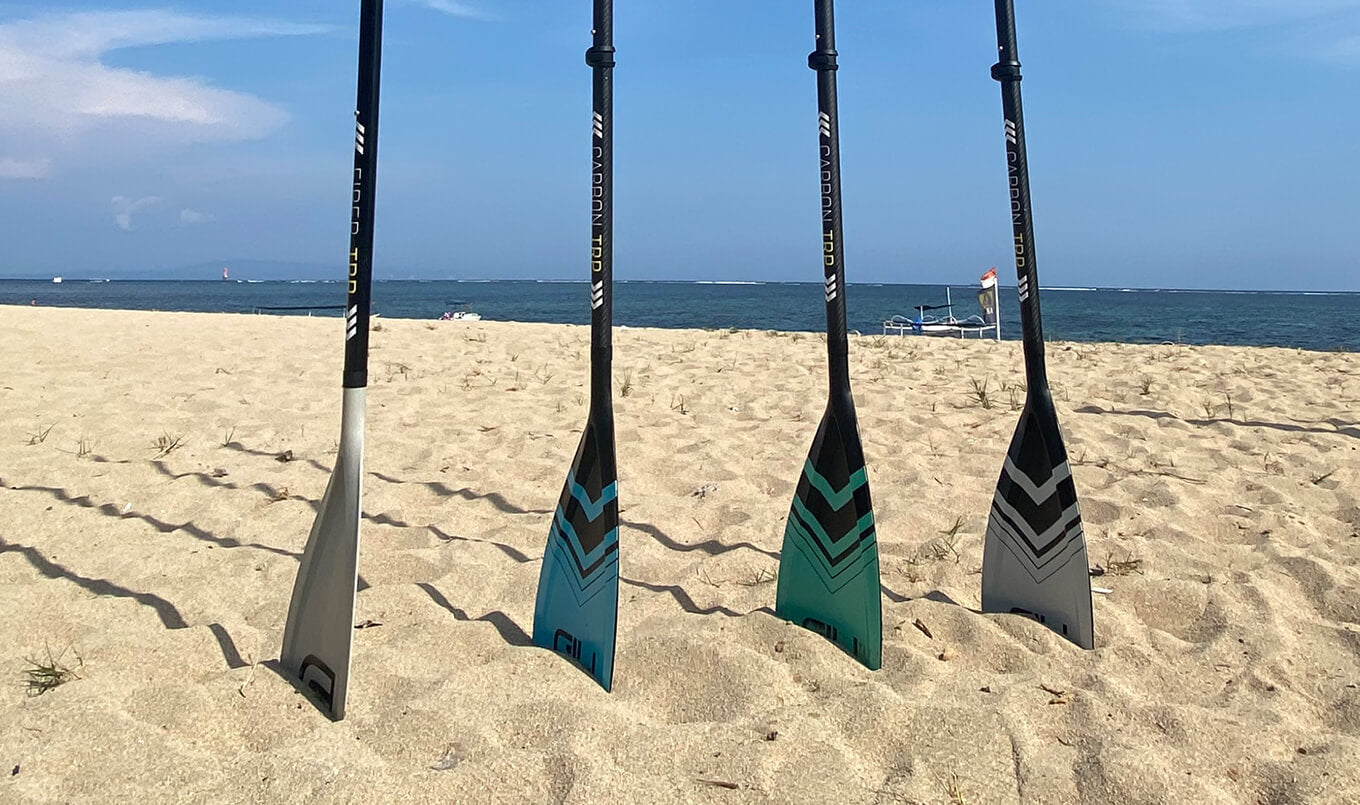
You should always use a paddle board leash. With a leash, you don’t need to worry about your paddle getting jerked out of your hand and floating away when you fall.

Personal flotation devices are always a good idea for safety, but sometimes they’re also the law. In the US, for example, any paddle board venturing outside of a surfing or swimming area must have a life jacket on board for each passenger, and kids 12 or younger must be wearing their jackets. PFDs can be the first line of safety in an emergency, so they’re absolutely worth it.
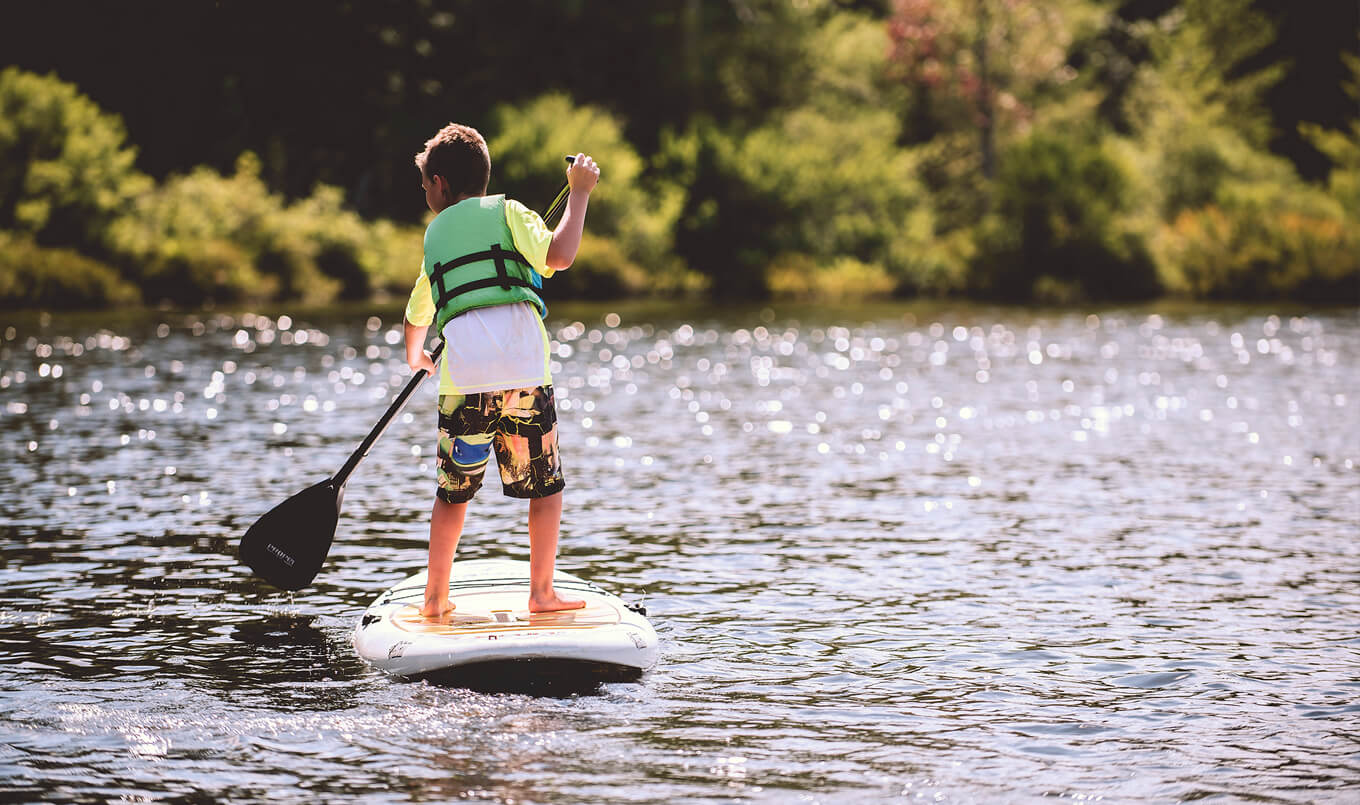
If you plan to paddle in the dark, a flashlight and safety whistle are absolutely essential. Safety first!
The paddle board clothing you need will boil down to what kind of weather you’ll be paddling in. If it’s chilly, you’ll need a wetsuit. If it’s warmer, you can paddle in your swimsuit, but a rash guard and hat can provide some extra sun protection. You might also want to paddle with a dry change of clothes.
On warmer days, you won’t need shoes on your SUP, but if you’re chilly, you’ll be totally fine wearing them. Shoes won’t damage your board. You’ll want to wear shoes designed for water, like deck shoes or water sport shoes. In cold water, opt for neoprene shoes to keep those toes toasty.
We all know by now that sunscreen is incredibly important, but here’s an ominous reminder: UV rays can reflect off of open water. In addition to sunscreen, you’ll want to consider hats, visors, and rash guards to protect you from those bright rays. No amount of aloe in the world can soothe a truly gnarly sunburn from a full day of SUP on the open water.
A dry bag can keep your most precious possessions safe from the water. You also may want a waterproof phone case, which you can keep inside the bag. If you want to add a little more excitement to your adventures, get yourself an action camera like a GoPro. Your dry bag is also a great place to keep your towel away from the water.

Your paddle board bag or iSUP backpack will help store and protect your board, so it’s important to pick a good one!
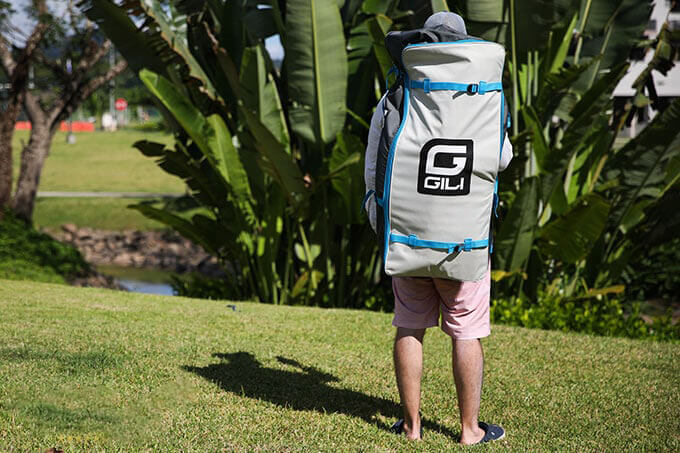
You’ll usually want to choose a paddle that’s about 9-10” taller than your height. Of course, there are exceptions. If you’re into SUP surfing, you’ll want a paddle that’s about 6”-7” above your height, and if you’re into SUP racing, you’ll want a paddle that’s about a foot above your height.
Most SUP paddles are adjustable, [see our tips on SUP paddle sizing methods], so the main thing to know is how to adjust your paddle so it fits you just right.
Size your paddle with the Hands Up Method. In one hand, hold your paddle up straight and parallel to your body, with the blade touching the ground. Hold your other hand straight up as if you’re about to do a pull up. Adjust your paddle to the height of the top of your pull up hand. Double check that the paddle grip feels comfortable in the palm of your hand, or keep adjusting until it does.
Once you’ve chosen the right height, push in the metal button on your paddle that allows you to adjust. Guide the handle up or down to reach the height you need, and make sure the button makes that satisfying clickto tell you it’s securely in place.
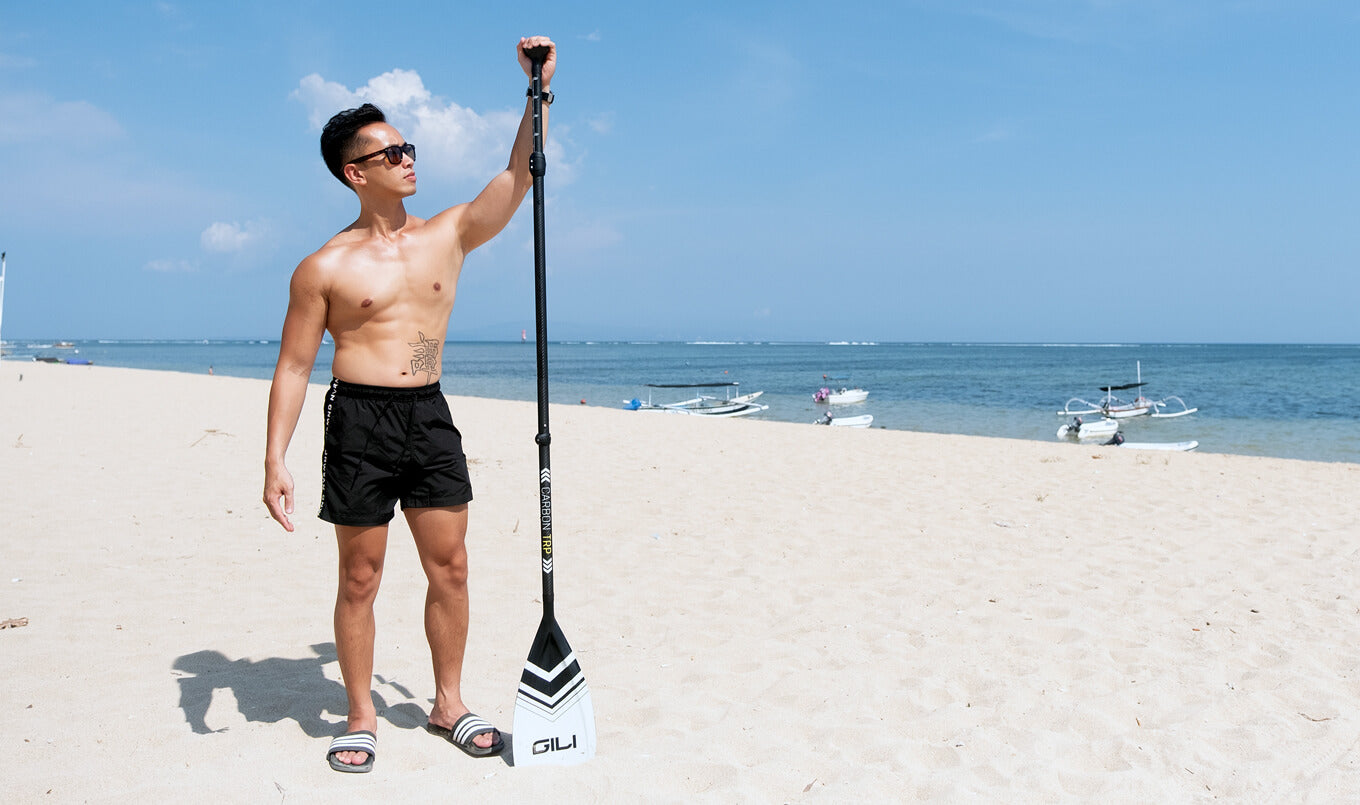
You’ve got the board, you’ve got the gear, and now you’re ready to - drumroll, please - take to the water. The first thing you’ll need to learn is how to launch your SUP.
First, walk into the water while carrying your board by its center handle. When you’re about knee-deep into the water, set the board on to the water’s surface. Place your paddle across your board, then sit with your knees on the board.
Practice paddling on your knees until you feel fairly comfortable. When you feel like you’re ready to try standing, it’s time to learn how to stand up!

Ready to put the “Stand Up” in SUP? Here’s how to do it: moving one foot at a time, place your feet in the place where your knees had been resting. Slowly rise up from a squat, with your heels flat, and slide your hands onto your paddle.
As soon as you stand up, make your first stroke with your paddle. This will help you build momentum and in turn, remain more steady. (Think of riding a bike: the more consistently you pedal, the more centered you feel.) If you’re struggling to balance, focus on engaging your core. Stand with your feet parallel and hip-width apart. Keep your toes facing forward and your knees slightly bent.
Wider boards can make it easier to balance, especially if you’re a beginner. Opt for a board that’s at least 31” wide, if not even wider.
Keep these tips in mind as you dip your toes into the wide waters of SUP.
Many beginners get started on a SUP that’s too small for them. When your board is too small, it can be difficult to maneuver and stay balanced. You’ll want to make sure you’re choosing a board that’s the right size for your needs and skill level.
Stand on the board with your feet hip-width apart and parallel. Point your toes forward, bend your knees, and look straight ahead. (You might feel tempted to look down, but don’t!) Engage your core, and make sure you’re paddling the right way.
The correct way to hold your SUP paddle may contradict your initial instinct. To hold it correctly, angle the paddle blade away from you, toward the nose of your board. Lightly hold the T-grip with one hand, and hold on to the shaft with the other. Rotate hand positions when you switch paddling from side to side.

Every paddler falls now and then, no matter how experienced. Aim to fall away from your board and flat into the water. Then, get right back on the horse - er, board. While treading water next to your board, grab onto the center handle, and use it to pull yourself up. Pull on the handle with your arm and kick with your legs to get back on your board.
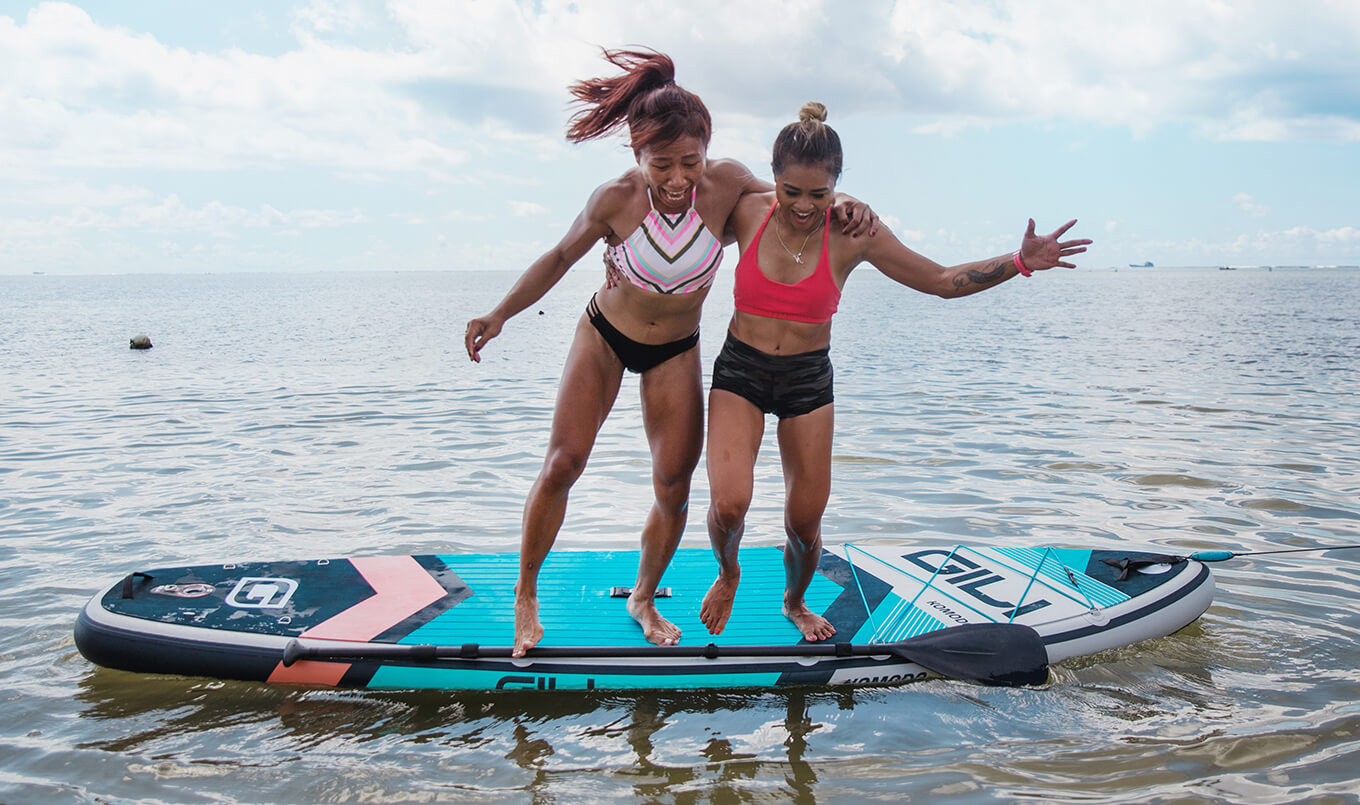
If you’re new to the open water, make sure you head out with an experienced fellow paddler. Be sure to check the weather in advance, and let someone know when and where you are going. Always make safety your priority.
Your core is stronger than your arms, so the benefits of this tip are two-fold. Engaging your core makes paddling easier and makes for an excellent low-impact exercise. Who needs a crowded aerobics class when you’ve got your board and the sparkling water beneath you? You’ll paddle faster and farther from your core than you ever will from your arms.
Before you hit the water, check the direction of the wind. Be sure to face towards the wind on your way out. This way, if you're fatigued on the way back, the wind can boost you instead of fight you. If you come across strong winds out on the water, get on your knees and move your hands toward the middle of the paddle’s shaft. If you need to, you can “row” the board, canoe style, until you can safely stand back up.
Keeping your head up high and looking straight out ahead will help you maintain balance on the board. Resist the urge to look down at your feet!
This will become second nature before you know it. You’ve got this!
Make sure you’ve got these strokes on lock before taking on advanced paddling techniques.
The forward stroke most vital of all paddle moves. To pull it off, start by rotating your hips and your shoulders, and holding the paddle out over the water’s surface with the blade angled forward. Put the paddle’s blade fully in the water, and glide the blade towards you.
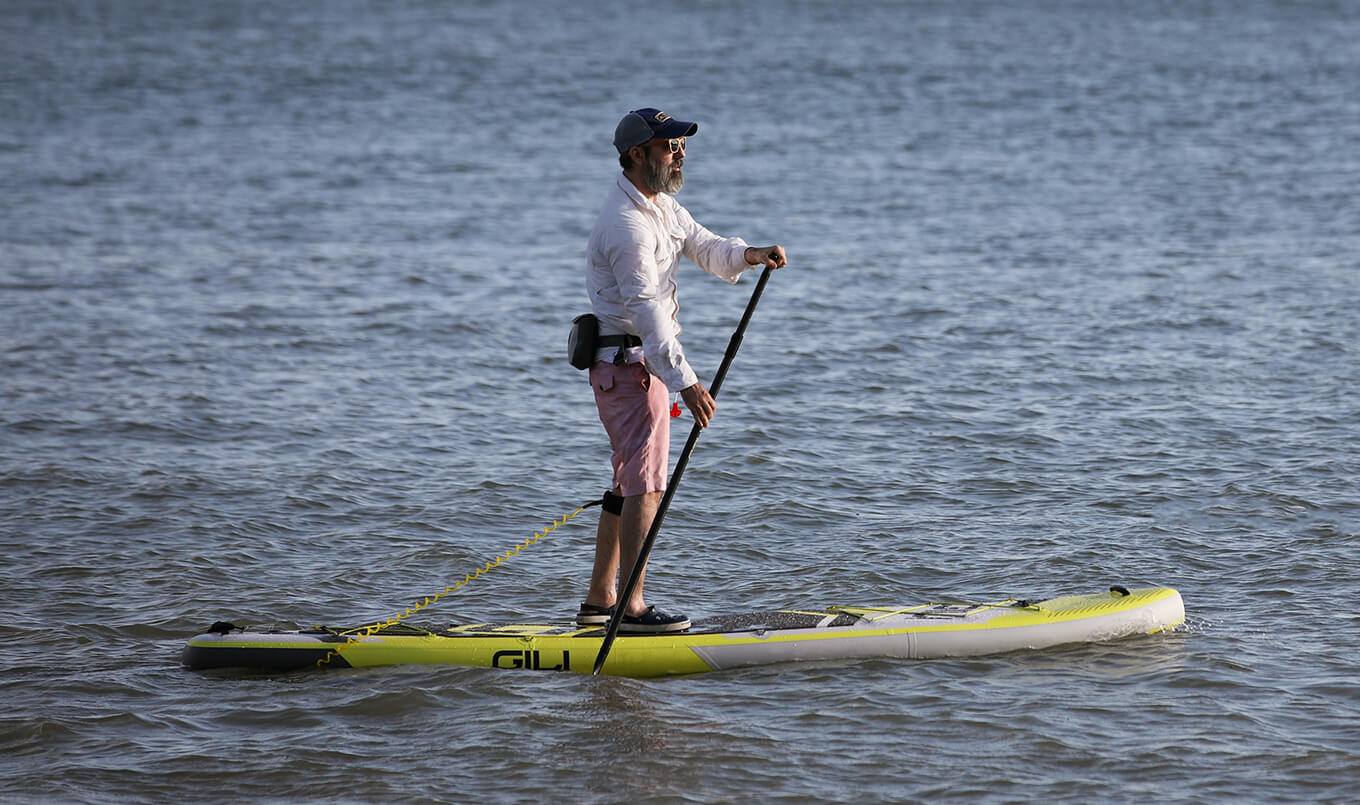
For this stroke, place the paddle in the water behind you, close to your board’s tail. When the blade is fully submerged in the water, hold your arms straight and twist your torso, moving the blade forward. When you execute a reserve stroke on the left side of your board, the nose of your board will move to the left (and vice versa.)
If you need to turn your SUP, start by bending your knees and lowering your arms. Plunge your paddle forward into the water, with the blade perpendicular to the paddle board. Then, you’ll want to sweep the paddle away from your board in a half-circle motion, from the nose to the tail.
You can perform a reverse sweep stroke by using this exact same motion, except start with maneuver with your paddle’s blade entering the water near your SUPs’ Tail, sweeping the paddle towards the nose.
This stroke can help move your board laterally. It’s ideal when you need to squeeze into a small space or pull up alongside something. To do a draw stroke, rotate your shoulders in the direction you want the board to go. Then, reach over the side of the board and put the paddle in the water with the blade facing parallel to the board. Then, you’ll want to pull the blade toward you. When you do this, the board will move in the paddle’s direction.
Look at this example:
For a little extra credit, you can start practicing the cross bow stroke, an advanced move that can help you turn swiftly, even when you’re standing in the middle of your board.
At the end of the day, your SUP will be coming home with you. So how will you get it there?
Hold onto your board’s center handle to move it most efficiently. You can also carry it at your side, but remember that paddle boards are bigger than surfboards. You might need to do some adjusting and finagling when first getting used to carrying your SUP.
If you have an inflatable SUP, you can deflate it and easily store it in your SUP backpack in the trunk of your car. If you have a hard SUP, you’ll need a car rack (or some other secure means of car transport) so that you can place it on the top of your car and secure it with cam straps.

If you have an inflatable SUP, flying with your board is pretty simple: you can deflate it, pack it up in a SUP backpack, and be on your merry way. If you have a hard SUP, you’ll want to make sure you have a durable case protecting the board. Arrive early to check in for your flight in case there are any hiccups, and research in advance about any oversize checked baggage fees.
Many people who have hard SUPs like to store them either on ceiling racks or wall racks. No matter how you store it, be sure your SUP’s weight is evenly distributed so it doesn’t get damaged.
Once you’ve chosen a board, practiced the basics, and taken to the water, the sky’s the limit to how much fun you can have. The most intimidating part of learning how to paddle board is just getting out there, so all you have to do is take that first step. Whether you want to master crow pose as a SUP yogi, hit the water with your best friend on board, or just paddle to wherever the day takes you, it’s all up to you.
Okay, the big moment has arrived - are you ready to take the leap? Keep these tips in mind on your first SUP outing.
What are you most excited to try on your SUP? Tell us in the comments!
This post is the single best free education piece I have found on paddling. I want all paddlers, new and “experienced” to read this. I was a self taught paddler for 5 years before I became professionally trained instructor and this information could have made me a better and safer paddler earlier.
Comments will be approved before showing up.
maría fernanda
August 10, 2022
Hello, I was wondering if you could help me with something.
I live in aventura, and I want to know if theres a regulation for the places where we can paddleboard (especially Dumfoundling Bay), I want to know if we can sail from wherever we want. Thank you